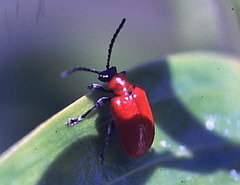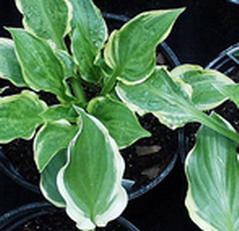|
Bugs And Diseases
|

Bugs
Some, like the
Iris Borer,
or
Tomato Hornworm
, have a larval stage that does all of the damage. The adult moth never eats and is only interested in sex. Once they mate and lay eggs their life is over. They also only fly at night. These habits make it almost impossible to control this beast by attempting to fight the adult moth. This type of life cycle is typical of many of our favourite? beasts.
The Red Lily Bug,
(pictured right,) on the other hand, has both adult and larva that are voracious eaters. This gives us, not only a reason, to hunt down the adults but also gives us a pathway to do so. These adults are always found on the leaves and they rarely fly so they are relatively easy to find and destroy.
Some of our most desireable trees such as the Paper or White Birch also are attacked by damaging insects such as the Birch Leaf Miner.
Even on our Houseplants we can find nasty things. In the unnatural atmosphere of our homes there are rarely any predators for the invading insects. The appearance of
hard shelled Scale Insects
requires some rather interesting defence techniques.
Spider Mites are a wide ranging pest on houseplants. They are not truly 'bugs' which makes controlling them interesting.
 Diseases
Diseases
On most of our ornamentals, fungus diseases such as mildew, are not fatal but only unsightly. For that reason it is usually easier to just learn to ignore the problem. There are some cultural things we can do, such as not getting the leaves wet at night, so that the water borne spores don’t get an easy way to spread. We can clean our gardening tools between each plant that we work on so that we don’t spread the problem from infected to healthy plants. This is particularly important for virus diseases such as the Hosta Virus, (see the puckering on the new leaves, pictured left,) that is starting to become a problem.
Soil Borne Pathogens
There are several diseases of our vegetable crops that are quite devastating and difficult to control because they are resident in the soil. The various verticillium wilts are a good example. Treating the infected plants is a waste of time and energy. By the time you observe the symptoms the plant is so well infected that there is almost no chance that you can stop it. Avoiding infected soil is the preferred method of control but that can be difficult in a back yard garden. Moving your tomatoes from the north to the south end of the garden is probably only a few metres at best. Attempt to find out just what the problem is and read the seed catalogues carefully. The plant breeders are always trying to develop new varieties that are resistant to these diseases.
The old axiom Know Thine Enemy is never more important than when doing battle in the garden. It can actually be somewhat interesting learning about them but also frequently very frustrating. You have a few minutes each day to spend on the attack and they have all day to plan and execute their defense.
Luckily we are often smarter.
You can search my entire site for answers to your other gardening mysteries.
Dallying In The Dirt
Regular Tips and Smiles from Ken’s Gardening Activities
return from Bugs to Ken's home page
